
トラスカラ古文書
Tlaxcala Codex, 1585

☆ Diego Muñoz Camargo著の『Historia de Tlaxcala』である。これは、スペインによる征服後のメキシコで16世紀に書かれた写本で、トラスカラ州の社会、政治、軍事、宗教、文化の歴史を 扱っている。この写本が選ばれた理由は、美しい上にユニークで歴史的に重要なだけでなく、現在ロンドンの王立アカデミーのアステカ展で展示されているから だ。この展覧会は、アステカ文明の素晴らしさ、多様性、洗練さを強調する350点の優れた作品を集めた、アステカ文化に関する最も包括的な調査である。グラスゴー大学所蔵のムニョス・カマルゴのトラスカラ史.
PROVINCIAS DE LA NUEVA ESPAÑA. (SIGLO XVI-XVIII)
★Historia prehispánica de Tlaxcala︎▶︎▶︎︎▶︎▶︎︎▶︎▶︎︎▶︎▶︎︎▶︎▶︎
| The
choice for the first book of the month of 2003 is Diego Muñoz Camargo's
Historia de Tlaxcala. This is a Sixteenth Century manuscript
originating in post-Spanish conquest Mexico and deals with the social,
political, military, religious and cultural history of the Province of
Tlaxcala. This manuscript has been chosen not only because it is
beautiful, unique and historically important but also because it is
currently being exhibited in London at the Royal Academy's Aztecs
exhibition. This exhibition is the most comprehensive survey of Aztec
culture ever mounted, bringing together some 350 outstanding works
highlighting the splendours, variety and sophistication of the Aztec
civilisation. |
2003
年最初の書籍として選ばれたのは、Diego Muñoz Camargo著の『Historia de
Tlaxcala』である。これは、スペインによる征服後のメキシコで16世紀に書かれた写本で、トラスカラ州の社会、政治、軍事、宗教、文化の歴史を
扱っている。この写本が選ばれた理由は、美しい上にユニークで歴史的に重要なだけでなく、現在ロンドンの王立アカデミーのアステカ展で展示されているから
だ。この展覧会は、アステカ文明の素晴らしさ、多様性、洗練さを強調する350点の優れた作品を集めた、アステカ文化に関する最も包括的な調査である。 |
| The
Historia is a very unusual manuscript in that it can be separated into
three different sections; one textual and two pictorial written in
Spanish and native Náhuatl. The three different sections have names in
their own right; the textual section is known as the Relaciones
Geográficas or Descripción de la ciudad y provincia de Tlaxcala while
the two pictorial sections are known as the Tlaxcala Calendar and
Tlaxcala Codex. Although the subjects and issues covered in all three
sections are linked, it is unclear whether they were all produced at
the same time, though it is known that they were not produced by the
same author. Written on European paper using pen and china-ink, the
manuscript survives bound in its original vellum with gilded and
goffered edges. The textual section is the easiest part to date, originally having been written between 1581 and 1584 by the Tlaxcaltecan historian, Diego Muñoz Camargo. The text is an extended version of the questionnaire, the Relaciones Geográfica, issued at the order of Philip II of Spain and sent to every town and province of New Spain. It covered topics such as population demographics, political jurisdictions, languages spoken, physical terrain and native vegetation to name but a few. The information gathered would provide a massive database on what the Spanish Empire comprised of and the possibilities achievable for the Crown with the resources at its disposal. |
Historia
は、3つの異なるセクションに分けることができるという点で、非常に珍しい写本である。1つはテキスト、残りの2つは絵で、スペイン語とナワトル語で書か
れている。3つの異なるセクションにはそれぞれ固有の名称があり、テキストセクションはRelaciones
GeográficasまたはDescripción de la ciudad y provincia de
Tlaxcalaとして知られている。一方、絵で描かれた2つのセクションは、Tlaxcala CalendarとTlaxcala
Codexとして知られている。3つのセクションで扱われている主題や問題は関連しているが、それらが同時に作成されたものかどうかは不明である。ただ
し、同じ著者によって作成されたものではないことはわかっている。ヨーロッパの紙にペンと墨汁で書かれたこの写本は、金箔と透かし細工が施された縁取りの
ある羊皮紙に綴じられた状態で現存している。 テキスト部分は年代を特定するのが最も容易であり、もともとは1581年から1584年の間に、トスカラテカ族の歴史家ディエゴ・ムニョス・カマルゴに よって書かれたものである。テキストは、スペイン王フェリペ2世の命により、ヌエバ・エスパーニャのすべての町と州に送られた質問表『地理的関係 (Relaciones Geográfica)』の拡張版である。人口統計、政治管轄、使用言語、地形、自生植物など、さまざまなトピックが含まれていた。収集された情報は、ス ペイン帝国の構成要素に関する膨大なデータベースとなり、王冠が利用可能なリソースで達成可能な可能性を示した。 |
| Folio 249r Christopher Columbus symbolically offers the "New World" to Charles V 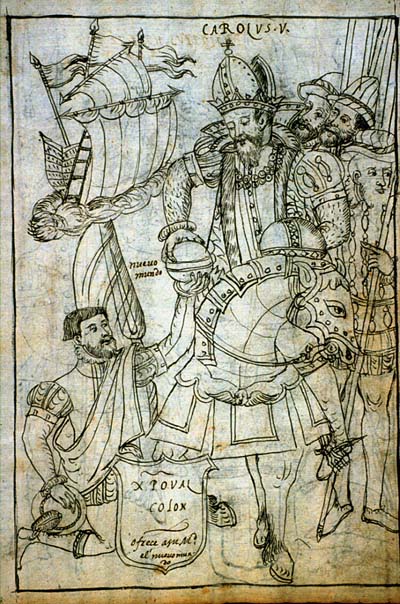 |
249rページ クリストファー・コロンブスが象徴的に「新世界」をカール5世に差し出す  |
| The
task of commissioning a response to the questionnaire in the Province
of Tlaxcala fell to the alcade mayor, the Alonso de Nava. He thought
Diego Muñoz Camargo, an educated mestizo (half-Indian, half-Spanish)
the most appropriate person to prepare a report. Camargo was the son
(probably illegitimate) of a Spanish conquistador and an indigenous
Indian woman. He spent a good period of his youth in Mexico City where
he became fluent in Spanish and the local Indian language, Náhuatl,
through teaching Indians who had been brought back from Florida.
Camargo became acquainted with Tlaxcala through properties his father
owned in the town, later settling and marrying a Tlaxcaltecan
noblewoman, Leonor Vázquez. He was well enough respected and had a good
enough grounding in native Tlaxcaltecan history and language that few
would have been more qualified for the task of writing the Relaciones
Geográfica. Both the textual Descripción de la ciudad y provincia de Tlaxcala and the supplementary pictorial Tlaxcala Codex deal with the history of the province of Tlaxcala from the beginning of the conquest of the region by the Spanish. At the time of Hernan Cortés' arrival (1519), the Mexican plateau was predominantly populated by Náhuatl-speaking Indians whose close-knit political organisation, the Aztec empire, had been developing for around 150 years. The one great exception to this Sixteenth Century superpower was the province of Tlaxcala. Sitting to the east of Tenochtitlán (Mexico City), the Tlaxcaltecas had defended a territory of some size and held the Aztecs, or Mexicas as they are often known, at bay while the Aztec Empire began to engulf them. On their arrival, the Spanish were welcomed with open arms by the Tlaxcaltecas who became their main indigenous ally in the war to conquer the Aztec Empire. |
ト
ラスカラ州でのアンケート調査の実施を命じたのは、アルカルデ・メイオール(代官)のアロンソ・デ・ナヴァであった。彼は、教育を受けたメスティーソ(ス
ペイン人とインディアンの混血)であるディエゴ・ムニョス・カマルゴが報告書を作成するのに最もふさわしい人物であると考えた。カマルゴは、スペイン人コ
ンキスタドールと先住民インディアンの女性との間の息子(おそらく非嫡出子)であった。彼は青年期の大部分をメキシコシティで過ごし、フロリダから連れ戻
されたインディオたちに教えることで、スペイン語と現地のインディオの言語であるナワトル語に堪能となった。
父親が町に所有していた土地を通じて、カマルゴはトラスカラと知り合いになり、後にトラスカラの貴族女性レオノール・バスケスと結婚して定住した。彼は十
分に尊敬され、先住民のトラスカラ人の歴史と言語に精通していたため、地理的関係を著述するというその任務にふさわしい人物であった。 テキストの「トラスカラ州の記述」と、それを補足する絵画の「トラスカラ・コデックス」は、いずれもスペインによる征服の始まりからトラスカラ州の歴史を 扱っている。エルナン・コルテスが到着した当時(1519年)、メキシコ高原は主にナワトル語を話すインディアンが居住しており、彼らは緊密な政治組織で あるアステカ帝国を約150年にわたって築き上げていた。この16世紀の超大国における唯一の例外がトラスカラ州であった。テノチティトラン(現在のメキ シコシティ)の東に位置するトラスカテカス族は、アステカ帝国が彼らを飲み込み始めた際、かなりの規模の領土を守り、アステカ人(またはメキシカ人)を寄 せ付けなかった。スペイン人が到着した際、トラスカテカス族は彼らを心から歓迎し、アステカ帝国征服戦争における先住民の主要な同盟国となった。 |
| Folio 239v The erection of the first cross in New Spain by the twelve friars from the order of St. Francis 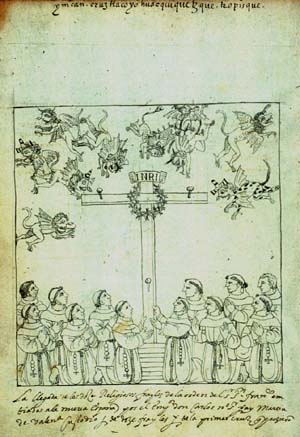 |
フォリオ239v 新スペインにおける聖フランシスコ会の修道士12人による最初の十字架建立  |
| The
Tlaxcala Codex can be considered a supplementary section of Camargo's
Descripción, as they both deal with the same topics; the joint history
of the Tlaxcaltecas and the Spanish in their wars against the Aztecs
and the evangelical battle for Christianity. The Codex comprises of 157
images drawn in pen and china-ink and then captioned above in Náhuatl
(although many of the Náhuatl captions have subsequently been lost
through cropping). Each image and caption has then been glossed
underneath in Spanish by a different hand. These drawings are almost
certainly not the work of Camargo since certain errors exist in the
drawings and captions that suggest a less-well-informed person carried
out the work. It has been suggested that the Codex might in fact be an
independent work, copied in whole, or part from an existing work. Some
eighty of the drawings appear to be nearly identical to those found on
the Lienzo de Tlaxcala, a mid Sixteenth Century Mexican manuscript
which may have acted as a form of template for the Codex. |
ト
ラスカラ・コデックスは、カマルゴの『記述』の補足部分と考えることができる。両者は同じトピック、すなわちトラスカテカ族とスペイン人のアステカ族との
戦いとキリスト教の布教のための戦いの歴史を扱っているからだ。この写本は、ペンと墨で描かれた157枚の絵で構成されており、ナワトル語のキャプション
が上に付けられている(ただし、ナワトル語のキャプションの多くは、トリミングにより後に失われた)。各絵とキャプションの下には、別の筆者によるスペイ
ン語の注釈が付けられている。これらの絵は、おそらくカマルゴの作品ではない。絵やキャプションには、知識が浅い人物が描いたことを示すいくつかの誤りが
あるからだ。この写本は、実際には既存の作品から全体または一部を複写した独立した作品である可能性もある。80点ほどの図は、16世紀半ばのメキシコの
写本であるLienzo de Tlaxcala(トラスカラの絵巻)の図とほぼ同一である。このLienzo de
Tlaxcalaは、Codexのテンプレートのような役割を果たした可能性がある。 |
| Detail from folio 239r Caption in Náhuatl describes how people are killed in the "house of the devil". Many original captions were lost through cropping when the manuscript was bound  |
239rページの詳細 ナワトル語のキャプションは、「悪魔の館」でどのように人々が殺されるかを説明している。多くのオリジナルのキャプ ションは、写本が製本された際にトリミングされて失われた。 
|
| Folio 239r A human sacrifice ceremony observed by Spaniards. They are denounced for holding the pagan offering of a decapitated quail 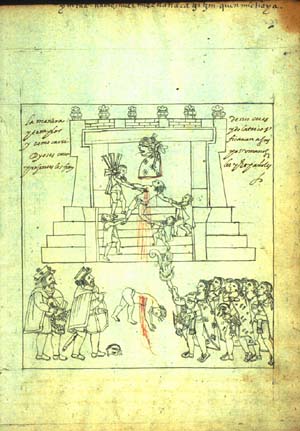 |
239rページ スペイン人による人柱の儀式の様子。異教徒の供物としてウズラ?(quail )の首を切ったとして非難されている。  |
| The
text and accompanying Codex drawings deal with many different events
and nuances of Sixteenth Century Tlaxcaltecan life. The city of
Tlaxcala is described, with all of its main streets and buildings; the
Casas Reales of the four leaders of Tlaxcala along with the churches
and monasteries established are all detailed. The allied campaign that
the Tlaxcaltecas and Spanish waged against the Aztecs is documented in
full. The battle of Cholula and its subsequent destruction, the death
of the Aztec King, Motecuhzoma II, the noche triste, where the Spanish
were driven from Tenochtitlán, the battle of Otumba and the final
battle for Mexico are all described. |
本
文と添えられたコーデックスの挿絵は、16世紀のトラスカルテカ族の生活におけるさまざまな出来事やニュアンスを扱っている。トラスカラ市の様子が、主な
通りや建物とともに描かれている。トラスカラの4人の指導者のカサ・レアル(王宮)や、建てられた教会や修道院もすべて詳細に描かれている。トラスカルテ
カ族とスペイン人がアステカ族に対して
チョルーラの戦いとその後の破壊、アステカ王モテスクゾマ2世の死、スペイン人がテノチティトランから追い出された「悲しみの夜」、オトンバの戦い、そし
てメキシコでの最終決戦など、すべてが記述されている。 |
| Folio 245v A map of the monastery of Tlaxcala including the church, bell tower, orchard and 73 steps to the church patio  |
|
| Folio 316r The battle of Nochtlan 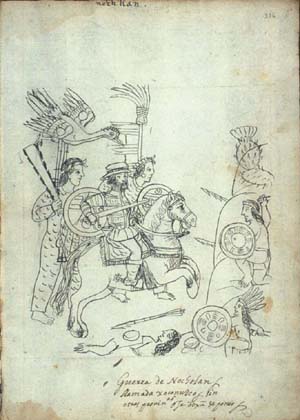 |
|
| The
evangelical battle to convert the Indians from their traditional gods
to the Christian faith is also documented. From the arrival of the
first twelve Franciscan friars, the erection of the first cross, the
first baptisms, to the meting out of swift justice to those converts
slipping back into "idolatrous" ways. In order to evangelise the
Indians, the Spanish seemed determined to show the power of their god
over the polytheist native religion. This not only involved preaching
of the gospel but also the destruction of indigenous places of worship
and the burning of many ancient written religious and cultural
histories. Camargo is very critical of these destructive acts; as a
historian he would have recognised the irreparable damage being done in
the Spanish drive to convert the Indians to Christianity. He recognised
the importance of preserving whatever history the Indians still had and
spent much time in his text describing the traditional beliefs of the
Indians. He describes the belief in the existence of four worlds before
the current one and traditional ideas on genesis. This recognition in
the importance of traditional culture and history is probably why the
third pictorial section of the Historia; the Tlaxcala Calendar is
included. |
先住民を彼らの
伝統的な神々からキリスト教信仰に改宗させるための福音主義者の戦いも記録されている。最初の12人のフランシスコ会の修道士の到着から、最初の十字架の
建立、最初の洗礼、そして「偶像崇拝」に逆戻りした改宗者たちへの迅速な処罰まで。先住民を改宗させるために、スペイン人は多神教の土着宗教に対して自分
たちの神の力を示すことに固執していたようだ。これは福音の説教だけでなく、土着の礼拝所の破壊や、古代の宗教的・文化的な歴史を記した文書の焼却も伴っ
ていた。カマルゴはこうした破壊的な行為を厳しく批判している。歴史家として、スペイン人がインディオをキリスト教に改宗させるために行った、取り返しの
つかない損害を認識していたからである。彼はインディオがまだ持っていた歴史を保存することの重要性を認識しており、著書の中でインディオの伝統的信仰に
ついて多くの時間を割いて説明している。彼は、現在の世界以前に4つの世界が存在するという信仰や、起源に関する伝統的な考え方を説明している。このよう
な伝統文化や歴史の重要性を認識していたからこそ、おそらく『ヒストリア』の3つ目の図版セクションとして、トラスカラ暦が含まれているのだろう。 |
| Folio 242r Franciscan friars burning traditional books and clothes. The images in the fire represent the destruction of the old gods whose masks correspond to the twenty signs of the tonalamatl  |
242rページ フランシスコ会の修道士たちが伝統的な書物や衣服を燃やしている。火の中に描かれたイメージは、トナラマトルの20の兆候に対応する仮面を被った古い神々の破壊を表している(→「知識のコロニアリティ」)。 |
| Folio 241v Punishment and "justice" for a convert to Christianity who has "slid back" into idolatry ways. According to the Náhuatl caption he is to be hanged the very next day 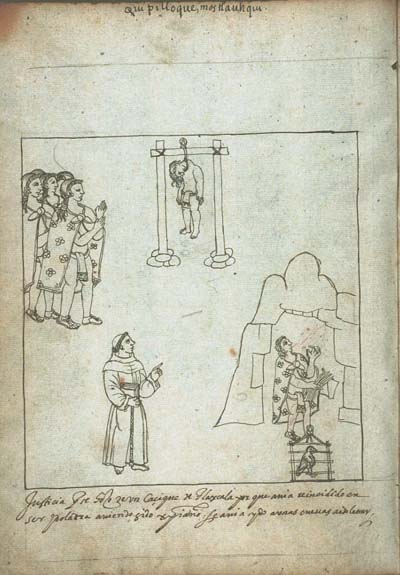 |
フォリオ 241v 偶像崇拝に「後戻り」したキリスト教への改宗者に対する(異端審問抜きの)処罰と「正義」。ナワトル語のキャプションによると、彼は翌日に絞首刑にされることになっている。 上段はナワトル語のキャプション quipilloque mostlauhqui= Le colgaron en la mañana. 下段はスペイン語のキャプション justicia que se hizo de un cacique de Tlaxcala porque había reiniciado en ser idólatra habiendo sido cristiano, se había ido a unas cuevas a idolatrar |
| The Calendar comprises two
separate astronomical diagrams describing the traditional Mexican
calendrical system. These diagrams take the form of two calendar wheels
that are found between folios 177 and 178 of the manuscript. The first,
designed by Francisco de las Navas, a Franciscan monk correlates the
twenty signs of the tonalamatl, at the centre, with the 52 years of the
xiuhmolpilli, at the circumference, showing how the four special signs
combine with thirteen special numbers to produce 52 year names. These
are further correlated with the Christian calendar, from 1 Reed (1519)
when Cortés arrived to 13 Rabbit (1570). The second calendar wheel was
designed by an Indian governor of Tlaxcala, Antonio de Guevara. It
shows, 18 months of the Mexican year and the five days without feasts
of the 365 day year; the sign for each feast, an explanation of the
sign and the name and the correlation with the months of the Christian
calendar. A note explains how each month is divided into a 20-day
period named after the moon, meztli, which is depicted in the centre of
the wheel. Among the many calendar wheels included in histories of the
Spanish colonial period, these two wheels have the acknowledged
distinction of being the earliest. Although Camargo is very critical of the acts of cultural and historical destruction perpetrated by the Spanish, the overall tone of the Historia is far more ambivalent. The shared history of the Tlaxcaltecas and Spanish and the unique relationship they maintain is suggested quite deliberately throughout. The Historia was compiled as a gift for Philip II and these references were almost certainly an attempt to curry favour with the Crown and establish privileges for the Tlaxcaltecas. Camargo was interpreter for a Tlaxcaltecan delegation of Indians including Antonio de Guevara who travelled to Spain in 1584. It was in Madrid, the next year, that the copying and binding of the Historia was finally completed. The purpose of this visit was to secure additional privileges for the Tlaxcaltecan court; the adulatory nature of the Historia may have assisted the delegation, for the same year Royal cedulas were issued granting a series of new exemptions and immunities to Tlaxcala. However, the benefits - irregardless of the manuscript's significance in their being granted - were short-lived. Subsequent years saw the Spanish authorities pursue a rigorous programme imposing stronger Crown control over New World territories in order to ensure maximum profit: this included the reversal of Tlaxcala's exemptions. As Eleanor Wake notes, very quickly, "Tlaxcala became but another source of tributary income". |
カレンダーは、メキシコの伝統的な暦法を説明する2つの天文学的図表か
ら構成されている。これらの図表は、写本の177ページ目と178ページ目の間に見られる2つのカレンダーホイールの形をしている。最初のものは、フラン
シスコ会の修道士フランシスコ・デ・ラス・ナバスがデザインしたもので、中心のトナラマトル(tonalamatl)の20の記号と、外周のシウモルピリ
(xiuhmolpilli)の52年を関連付け、4つの特別な記号が13の特別な数字と組み合わさって52年周期の名称が生まれる仕組みを示している。
これらはさらに、コルテスが到着した1519年の「葦」から1570年の「卯」までのキリスト教暦と関連付けられている。2つ目のカレンダーホイールは、
トラスカラの総督であったアントニオ・デ・ゲバラによってデザインされた。このホイールには、メキシコの1年の18か月と365日のうちの5日間の祝日な
しの日が示されている。それぞれの祝日の記号、その記号の説明、名称、キリスト教の暦の月との関連が示されている。各月の名称が月の名前に由来する20日
間の期間に分けられていることについての説明が添えられている。スペイン植民地時代の歴史に登場する数多くのカレンダーホイールの中でも、この2つのホ
イールは最も古いものと認められている。 カマルゴはスペイン人による文化と歴史の破壊行為を厳しく批判しているが、『Historia 』の全体的なトーンははるかに複雑である。トランカステカ族とスペインの共有の歴史と、両者の独特な関係は、全体を通してかなり意図的に示唆されている。 『歴史書』はフェリペ2世への贈り物として編纂されたものであり、これらの言及は、おそらく王の寵愛を得てトランカステカ族の特権を確立しようとする試み であった。カマルゴは、1584年にスペインを訪れたアントニオ・デ・ゲバラを含むトランカステカ族の使節団の通訳を務めた。翌年、マドリッドでようやく 『歴史』の写本と製本が完成した。この訪問の目的は、トスカラテカの宮廷にさらなる特権を確保することであった。『歴史』の賛美的な内容が、代表団にとっ て有利に働いた可能性もある。なぜなら、その年にはトスカラテカに一連の新たな免除と免責を与える王令が発布されたからだ。しかし、その恩恵は、写本の重 要性に関わらず、長くは続かなかった。その後の数年間、スペイン当局は利益を最大限に確保するために、新世界領土に対する王権の支配を強化する厳格なプロ グラムを推進した。これには、トラスカラの免税措置の廃止も含まれていた。エレノア・ウェイクが指摘しているように、トラスカラは「貢ぎ物の収入源のひと つにすぎなくなった」のである。 |
Recto of insert between folio 177 and 178 Verso of insert between folio 177 and 178 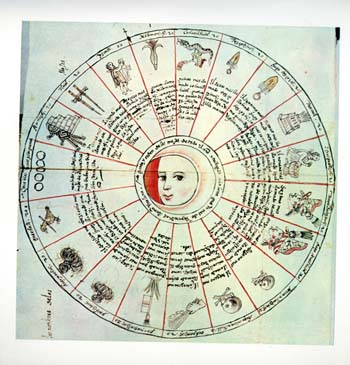 |
177ページと178ページの間の差し込みの表 |
| The Historia de Tlaxcala appears
to have remained in the Biblioteca Real, housed in El Escorial near
Madrid at least until the early Seventeenth Century after which its
fate becomes obscure until purchased by Dr. William Hunter for his
museum established in 1768. Upon his death, Hunter bequeathed his
collection; the Historia included, to Glasgow University. The
manuscript remained largely unknown to scholars for some considerable
time and did not appear on the census of Mesoamerican manuscripts of
1975. René Acuña published the first facsimile edition of the
manuscript under the title Descripción de la ciudad y provincia de
Tlaxcala, Mexico in 1981 and the Historia has since gained deserved and
widespread recognition as one of the most historically important early
Mesoamerican documents extant. |
『トラスカラ史』は少なくとも17世紀初頭まではマドリード近郊のエ
ル・エスコリアルに置かれた王立図書館に保管されていたようだが、その後は1768年にウィリアム・ハンター博士が自身の博物館のために購入するまでその
行方は不明である。ハンターの死後、彼のコレクションはグラスゴー大学に遺贈された。この写本は長い間、学者たちにはほとんど知られておらず、1975年
のメソアメリカ写本の目録にも記載されていなかった。1981年にルネ・アキュナが『メキシコ、トラスカラ州の都市と州の記述』というタイトルでこの写本
の最初のファクシミリ版を出版して以来、『ヒストリア』は現存する最も歴史的に重要な初期メソアメリカ文書の一つとして、正当な評価と広く認知されるよう
になった。 |
| Other items of interest Visit the Royal Academy's Aztecs exhibition website. The exhibition runs from 16 November 2002 until 11 April 2003 Although the original is restricted, the facsimile edition of MS Hunter 242 (U.3.15), Descripción de la ciudad y provincia de Tlaxcala de las Indias y del mar océano para el buen gobierno y ennoblecimiento dellas. By Diego Muñoz Camargo, ed. by René Acuña. 1981. UNAM : Mexico can be consulted at Sp Coll RF 76 The following books have been very helpful in compiling this article: Acuña, René, 1984. Relaciones Geográficas del Siglo XVI: Tlaxcala. UNAM : Mexico. Sp Coll Hunterian Add. 210 Berger, Una, 1988. Mexican painted manuscripts in the United Kingdom. [British Museum Occasional Paper 91] British Museum : London. Sp Coll Hunterian Add. f74 Brotherston, Gordon, 1995. Painted books from Mexico; codices in UK collections and the world they represent. British Museum : London. Sp Coll Hunterian Add. 271 Gibson, Charles, 1950. The identity of Diego Munoz Camargo. The Hispanic American Historical Review 30:2:195-208 (available from JSTOR) Gibson, Charles, 1967. Tlaxcala in the Sixteenth Century. Stanford University Press : Stanford, Ca.. Main Library History UA854 GIB Morner, Magnus and Gibson, Charles, 1962. Diego Munoz Camargo and the Segregation Policy of the Spanish Crown. The Hispanic American Historical Review 42:4:558-568 (available from JSTOR) The State of Tlaxcala, 1994. Government of the State of Tlaxcala : Mexico. Sp Coll Hunterian Add, q77 Wake, Eleanor, 2002. Codex Tlaxcala: new insights an new questions. Estudios de Cultura Náhuatl 33: 91-140 (available from: http://www.ejournal.unam.mx) |
その他の興味深い項目 王立アカデミーのアステカ展ウェブサイトを訪問する。この展覧会は2002年11月16日から2003年4月11日まで開催されている 原本は閲覧制限があるが、ハンター文書館蔵書242(U.3.15)の複製版『メキシコ・トラスカラ州の都市と州の記述:優れた統治と貴族化のために』 ディエゴ・ムニョス・カマルゴ著、ルネ・アクーニャ編、1981年、UNAM:メキシコは、Sp Coll RF 76で閲覧可能である 本記事の執筆にあたり、以下の書籍は非常に参考になった。 Acuña, René, 1984. Relaciones Geográficas del Siglo XVI: Tlaxcala. UNAM : Mexico. Sp Coll Hunterian Add. 210 Berger, Una, 1988. Mexican painted manuscripts in the United Kingdom. [British Museum Occasional Paper 91] British Museum : London. Sp Coll Hunterian Add. f74 ブラザーストン、ゴードン、1995年。メキシコの彩色写本:英国所蔵のコーデックスと、それが表現する世界。大英博物館:ロンドン。Sp Coll Hunterian Add. 271 ギブソン、チャールズ、1950年。ディエゴ・ムニョス・カマルゴの正体。ヒスパニック・アメリカン・ヒストリカル・レビュー30:2:195-208(JSTORより入手可能) ギブソン、チャールズ、1967年。16世紀のトラスカラ。スタンフォード大学出版局:カリフォルニア州スタンフォード。メイン図書館歴史UA854 GIB モーナー、マグナス、ギブソン、チャールズ、1962年。ディエゴ・ムニョス・カマルゴとスペイン王家の隔離政策。ヒスパニック・アメリカン・ヒストリカル・レビュー42:4:558-568(JSTORより入手可能) トラスカラ州政府、1994年。メキシコ、トラスカラ州政府。Sp Coll Hunterian Add、q77 ウェイク、エレノア、2002年。トラスカラ・コデックス:新たな洞察と新たな疑問。ナワトル文化研究 33: 91-140(入手先:http://www.ejournal.unam.mx) |
| GLASGOW UNIVERSITY LIBRARY SPECIAL COLLECTIONS DEPARTMENT Book of the Month https://www.gla.ac.uk/myglasgow/library/files/special/exhibns/month/jan2003.html |
January 2003 Historia de Tlaxcala Mexico: 1585 Sp Coll MS Hunter 242 (U.3.15) |
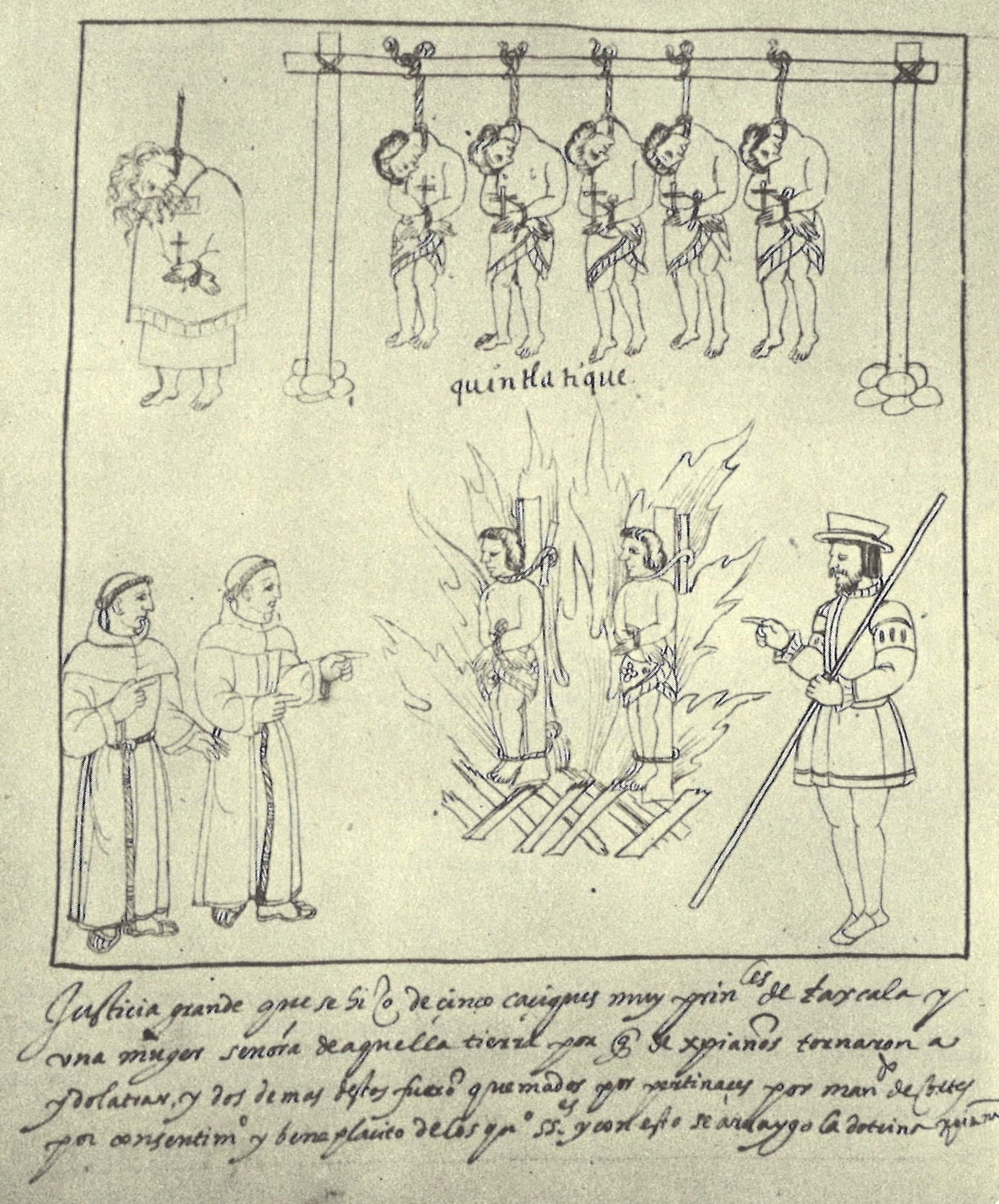

リ ンク
文 献
そ の他の情報
Copyleft, CC, Mitzub'ixi Quq Chi'j, 1996-2099
☆
 ☆
☆